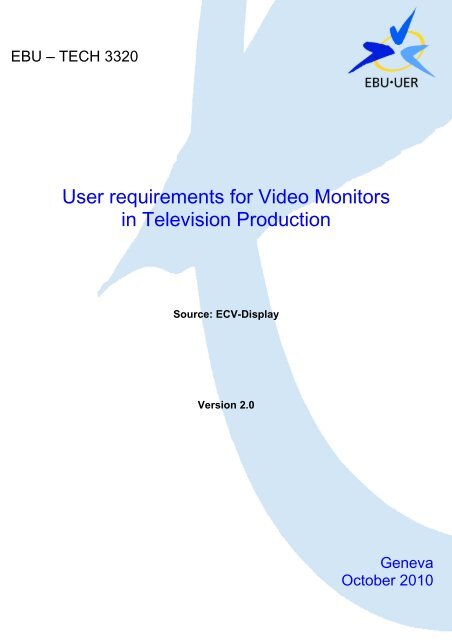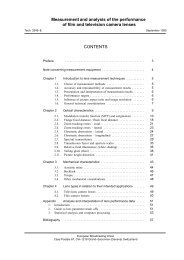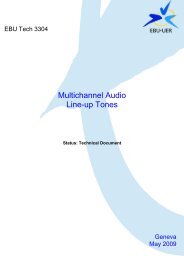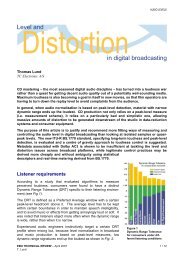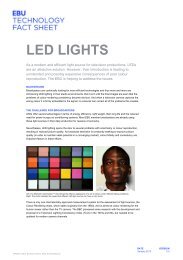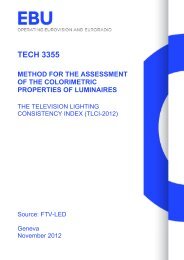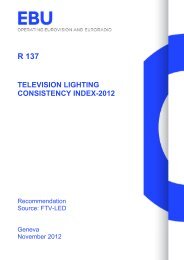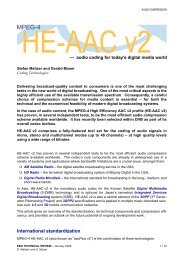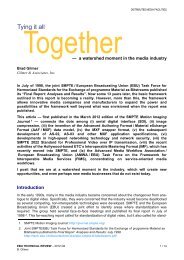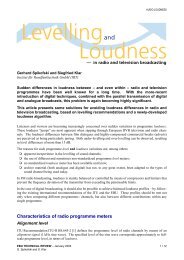User requirements for Video Monitors in Television ... - EBU Technical
User requirements for Video Monitors in Television ... - EBU Technical
User requirements for Video Monitors in Television ... - EBU Technical
Create successful ePaper yourself
Turn your PDF publications into a flip-book with our unique Google optimized e-Paper software.
<strong>EBU</strong> – TECH 3320<br />
<strong>User</strong> <strong>requirements</strong> <strong>for</strong> <strong>Video</strong> <strong>Monitors</strong><br />
<strong>in</strong> <strong>Television</strong> Production<br />
Source: ECV-Display<br />
Version 2.0<br />
1<br />
Geneva<br />
October 2010
Page <strong>in</strong>tentionally left blank. This document is pag<strong>in</strong>ated <strong>for</strong> two sided pr<strong>in</strong>t<strong>in</strong>g
Tech 3320<br />
<strong>User</strong> <strong>requirements</strong> <strong>for</strong> <strong>Video</strong> <strong>Monitors</strong> <strong>in</strong> <strong>Television</strong> Production<br />
Contents<br />
Scope ............................................................................................................ 5<br />
1. Def<strong>in</strong>ition of a Grade 1 monitor ........................................................................... 5<br />
2. Def<strong>in</strong>ition of a Grade 2 monitor ........................................................................... 6<br />
3. Def<strong>in</strong>ition of a Grade 3 monitor ........................................................................... 6<br />
4. Special application of displays............................................................................. 6<br />
4.1 Viewf<strong>in</strong>der monitors ......................................................................................6<br />
4.2 Displays used <strong>for</strong> set design .............................................................................6<br />
4.3 Displays used <strong>in</strong> location shoot<strong>in</strong>g, or on set/studio floor .........................................6<br />
5. Requirements ................................................................................................. 7<br />
5.1 Lum<strong>in</strong>ance ranges.........................................................................................7<br />
5.2 Black level..................................................................................................7<br />
5.3 Contrast ratio..............................................................................................8<br />
5.4 Gamma characteristics...................................................................................8<br />
5.5 Grey scale reproduction .................................................................................9<br />
5.6 Colour gamut and colour reproduction ................................................................9<br />
5.7 Colour temperature..................................................................................... 10<br />
5.8 View<strong>in</strong>g-angle dependency ............................................................................ 10<br />
5.9 Motion artefacts......................................................................................... 11<br />
5.10 Screen resolution........................................................................................ 11<br />
5.11 Image scal<strong>in</strong>g, de-<strong>in</strong>terlac<strong>in</strong>g and overscan ........................................................ 11<br />
5.12 Delay time................................................................................................ 12<br />
5.13 Screen size ............................................................................................... 12<br />
5.14 Uni<strong>for</strong>mity................................................................................................ 12<br />
5.15 Mura (imperfections <strong>in</strong> LCD panels).................................................................. 13<br />
5.16 Streak<strong>in</strong>g (also known as crosstalk, overspill or shadow<strong>in</strong>g) ..................................... 13<br />
5.17 Stability and environmental conditions ............................................................. 13<br />
5.18 Pixel defects ............................................................................................. 14<br />
5.19 R<strong>in</strong>g<strong>in</strong>g and handl<strong>in</strong>g of under- and over-shoots ................................................... 14<br />
5.20 Treatment of illegal signals ........................................................................... 14<br />
5.21 Image stick<strong>in</strong>g (long-term after-image) ............................................................. 15<br />
5.22 Supported Standards, and signal <strong>in</strong>terfaces ........................................................ 15<br />
5.23 Other facilities .......................................................................................... 16<br />
5.24 Acoustic Noise ........................................................................................... 16<br />
5.25 Surface reflectivity (glare) ............................................................................ 16<br />
6. References....................................................................................................18<br />
3
<strong>User</strong> <strong>requirements</strong> <strong>for</strong> <strong>Video</strong> <strong>Monitors</strong> <strong>in</strong> <strong>Television</strong> Production Tech 3320<br />
7. Bibliography:................................................................................................. 18<br />
Annex A: Gamma considerations.............................................................................. 19<br />
Annex B: CIE 1976 - the L*u*v* uni<strong>for</strong>m colour space, and chromaticity error calculations..... 21<br />
4
Tech 3320<br />
<strong>User</strong> <strong>requirements</strong> <strong>for</strong> <strong>Video</strong> <strong>Monitors</strong> <strong>in</strong> <strong>Television</strong> Production<br />
<strong>User</strong> <strong>requirements</strong> <strong>for</strong> <strong>Video</strong> <strong>Monitors</strong><br />
<strong>in</strong> <strong>Television</strong> Production<br />
<strong>EBU</strong> Committee First Issued Revised Re-issued<br />
(PMC) ECV 2007 * May ‘08, October 2010<br />
Keywords: <strong>User</strong> Requirements, Professional <strong>Video</strong> <strong>Monitors</strong>, <strong>Television</strong> Production<br />
Scope<br />
This document def<strong>in</strong>es classes of video broadcast monitors, and their application areas <strong>in</strong> television<br />
production. It also def<strong>in</strong>es the technical characteristics required of those monitors. Broadcast<br />
monitors are used <strong>in</strong> a professional TV production environment <strong>for</strong> evaluation and control of the<br />
images be<strong>in</strong>g produced, and must provide reliable and repeatable results. The purpose of a monitor<br />
is to display the signal as it is, and it must not attempt to ‘enhance’ or otherwise alter the image.<br />
It is unlikely that consumer devices will be able to meet these <strong>requirements</strong> <strong>in</strong> a television<br />
production environment. Home television receiver <strong>requirements</strong> and monitor <strong>requirements</strong> <strong>for</strong><br />
computer and data process<strong>in</strong>g techniques are not covered by this document.<br />
Colour measurement standards are lagg<strong>in</strong>g beh<strong>in</strong>d recent developments <strong>in</strong> light<strong>in</strong>g and displays,<br />
such that they no longer adequately describe the visual perception of those displays that make use<br />
of these developments. There<strong>for</strong>e, until new measurement standards are agreed <strong>in</strong>ternationally,<br />
this document cannot be an absolutely def<strong>in</strong>itive specification of the colour reproduction required,<br />
and can only be a guide as to the accuracy expected of a monitor.<br />
1. Def<strong>in</strong>ition of a Grade 1 monitor<br />
Grade 1 monitors are devices <strong>for</strong> high-Grade technical quality evaluation of picture captur<strong>in</strong>g, postproduction,<br />
transmission and storage. These monitors must possess at least the quality properties<br />
of the equipment to be controlled. It is expected that all applied technologies are state-of-the-art<br />
at this level. This means that artefacts should not be unduly masked nor should additional artefacts<br />
be <strong>in</strong>troduced. As a reference device the sett<strong>in</strong>gs of this type of monitor should be adjustable as<br />
well as lockable (mechanically or electrically), so that only authorized access is possible.<br />
The Grade 1 monitor is a ‘measur<strong>in</strong>g <strong>in</strong>strument’ <strong>for</strong> visual evaluation of image quality. There<strong>for</strong>e it<br />
would be highly desirable to have the ability to reproduce the scann<strong>in</strong>g mode of the signal <strong>in</strong> the<br />
native way (i.e. progressive or <strong>in</strong>terlaced) or as it is <strong>in</strong>tended to be viewed (e.g. 50 Hz presentation<br />
of 25p material).<br />
Typical applications <strong>for</strong> Grade 1 monitors are <strong>for</strong> example camera control, colour grad<strong>in</strong>g and<br />
quality control, and possibly light<strong>in</strong>g control positions, that is areas where video technical quality<br />
parameters are evaluated, controlled, and corrected.<br />
* First issued <strong>in</strong> May 2007. Re-issued as version 1.0a with corrected chapter number<strong>in</strong>g <strong>in</strong> June 2007.<br />
5
<strong>User</strong> <strong>requirements</strong> <strong>for</strong> <strong>Video</strong> <strong>Monitors</strong> <strong>in</strong> <strong>Television</strong> Production Tech 3320<br />
2. Def<strong>in</strong>ition of a Grade 2 monitor<br />
A Grade 2 monitor may have wider tolerances on its specification than a Grade 1 monitor, <strong>for</strong> the<br />
benefit of a significantly lower price, or smaller size or weight. Grade 2 monitors are used <strong>in</strong><br />
applications where tighter tolerances (<strong>for</strong> example on accuracy of colour reproduction and<br />
stability) as well as some equipment features, are not necessary.<br />
Areas of application <strong>for</strong> Grade 2 monitors are <strong>for</strong> example preview, control walls, edit suites, and<br />
control rooms if no picture quality manipulation is carried out.<br />
It should be possible <strong>for</strong> Grade 2 and Grade 1 monitors to be used together, <strong>for</strong> example <strong>in</strong><br />
television production control walls.<br />
3. Def<strong>in</strong>ition of a Grade 3 monitor<br />
Grade 3 (observation or presence) monitors are devices equivalent <strong>in</strong> many respects to high end<br />
domestic/consumer displays. For television production applications, important considerations<br />
<strong>in</strong>clude the availability of professional <strong>in</strong>terfaces, mechanical robustness (<strong>in</strong>clud<strong>in</strong>g the ability to<br />
mount <strong>in</strong> racks or stacks) and transportability, as well as electromagnetic compatibility and<br />
acoustic noise.<br />
Application areas <strong>for</strong> Grade 3 monitors are <strong>for</strong> example audio production, dialogue dubb<strong>in</strong>g, signal<br />
presence monitor<strong>in</strong>g, commentator positions and displays <strong>for</strong> the audience <strong>in</strong> a studio.<br />
4. Special application of displays<br />
4.1 Viewf<strong>in</strong>der monitors<br />
<strong>Monitors</strong> used as viewf<strong>in</strong>ders <strong>for</strong> television cameras are similar <strong>in</strong> many respects to Grade 2<br />
monitors. Picture quality <strong>requirements</strong> such as geometry and stability are important. A higher<br />
maximum brightness will be required, to allow <strong>for</strong> very different ambient light<strong>in</strong>g conditions. The<br />
viewf<strong>in</strong>der must provide facilities to assist <strong>in</strong> focus adjustment.<br />
4.2 Displays used <strong>for</strong> set design<br />
In the production area of broadcast companies the use of modern flat panel displays is more and<br />
more common, <strong>for</strong> example to produce large <strong>in</strong>-shot images as part of the set design. Unique<br />
factors <strong>for</strong> such monitors <strong>in</strong>clude the ability to match studio light<strong>in</strong>g (i.e. tungsten light, white<br />
balanced to 3200 K) and that they should have a particularly wide view<strong>in</strong>g angle and low delay. The<br />
issue of compatibility between studio cameras and displays that emit polarized light requires<br />
further study.<br />
4.3 Displays used <strong>in</strong> location shoot<strong>in</strong>g, or on set/studio floor<br />
These are monitors <strong>for</strong> use by the director, director of photography, or light<strong>in</strong>g cameraman, on set,<br />
both <strong>in</strong>doors and outdoors, <strong>for</strong> view<strong>in</strong>g material live from the camera. There is a potential<br />
requirement <strong>for</strong> such monitors to <strong>in</strong>clude the ability to simulate grad<strong>in</strong>g or another post-production<br />
process. The video data from the camera may <strong>for</strong> example be raw, logarithmic data, rather than<br />
matrixed and gamma-corrected data, and the director may there<strong>for</strong>e wish to preview a simulation<br />
of the <strong>in</strong>tended output appearance achieved at a later stage <strong>in</strong> TV production.<br />
6
Tech 3320<br />
<strong>User</strong> <strong>requirements</strong> <strong>for</strong> <strong>Video</strong> <strong>Monitors</strong> <strong>in</strong> <strong>Television</strong> Production<br />
5. Requirements<br />
Note: The specifications <strong>in</strong> this section are to be measured <strong>in</strong> accordance with <strong>EBU</strong> Tech 3325 [8].<br />
All specifications must be capable of be<strong>in</strong>g met simultaneously.<br />
5.1 Lum<strong>in</strong>ance ranges<br />
When a luma signal of 100% white (digital level is 940 <strong>in</strong> 10-bit systems, see Note 1) is <strong>in</strong>put, the<br />
display should provide an adjustable preset <strong>in</strong>clud<strong>in</strong>g the ability to produce a reference lum<strong>in</strong>ance<br />
level, <strong>for</strong> example of 80 cd/m 2 . However, it should be adjustable so that the 100% lum<strong>in</strong>ance (see<br />
Notes 2&3) on the screen can be set to provide lum<strong>in</strong>ance levels with<strong>in</strong> the ranges:<br />
Grade 1 Monitor: 70 to at least 100 cd/m 2 (Note 4).<br />
Grade 2 Monitor: 70 to at least 200 cd/m 2 .<br />
Grade 3 Monitor: 70 to 250 cd/m 2 or to 400 cd/m 2 <strong>in</strong> adverse conditions.<br />
Note 1:<br />
Note 2:<br />
100% lum<strong>in</strong>ance on the screen corresponds to a luma signal of digital level 940 (<strong>in</strong> 10-bit),<br />
and the black level corresponds to a luma signal of digital level 64 (<strong>in</strong> 10-bit). The highest<br />
value of luma signal is digital level 1019 (<strong>in</strong> 10-bit). The luma level 1019 is called ‘Superwhite’<br />
or ‘109% white’, by the <strong>for</strong>mula (1019 - 64)/(940 - 64) = 1.09.<br />
100% lum<strong>in</strong>ance on the screen is def<strong>in</strong>ed as the lum<strong>in</strong>ance of a luma signal of digital level<br />
940, but levels 941 through 1019 should also be correctly displayed and should track any<br />
adjustment made to the 100% lum<strong>in</strong>ance level.<br />
Note 3: The 100% lum<strong>in</strong>ance is measured on a white patch occupy<strong>in</strong>g the central 13.13%<br />
horizontally and vertically (as described <strong>in</strong> <strong>EBU</strong> Tech 3273, § 3.5), perpendicular to the<br />
centre of the screen.<br />
Note 4:<br />
Note 5:<br />
ITU-R BT.500-11 requires monitor brightness up to 200 cd/m 2 <strong>for</strong> tests simulat<strong>in</strong>g domestic<br />
view<strong>in</strong>g conditions.<br />
Automatic brightness limiters shall not be used <strong>for</strong> Grade 1 or Grade 2 <strong>Monitors</strong>.<br />
5.2 Black level<br />
With a luma signal at black level (digital level 64 <strong>in</strong> 10-bit), with a full-screen black test signal, the<br />
lum<strong>in</strong>ance level measured from the screen should be adjustable to be<br />
Grade 1 Monitor: below 0.05 cd/m 2 .<br />
Grade 2 Monitor: below 0.4 cd/m 2 .<br />
Grade 3 Monitor: below 0.7 cd/m 2 .<br />
It must be possible to adjust black level with a PLUGE test signal (<strong>in</strong>cl. sub-black) accord<strong>in</strong>g to the<br />
procedure outl<strong>in</strong>ed <strong>in</strong> ITU-R Rec. BT.814. We expect Grade 1 and 2 monitors to be used <strong>in</strong> control<br />
rooms with subdued light<strong>in</strong>g, <strong>for</strong> example ISO 12608 ‘C<strong>in</strong>ematography - Room and conditions <strong>for</strong><br />
evaluat<strong>in</strong>g television from telec<strong>in</strong>e reproduction’.<br />
Care must be taken to avoid veil<strong>in</strong>g glare <strong>in</strong> the measurement <strong>in</strong>strument, by the use of a mask or a<br />
frustum, as described <strong>in</strong> <strong>EBU</strong> Tech 3325 [8].<br />
Note:<br />
If the view<strong>in</strong>g conditions are standard dim surround (15% as <strong>in</strong> ITU-R Rec. BT.500-11) then<br />
the remission factor of the display must also be considered.<br />
In the case of a CRT, it appears that the black level measured with the screen switched off,<br />
<strong>in</strong> typical production environment, is between 0.05 and 0.1 cd/m 2 and about 0.01 cd/m 2<br />
higher with the screen switched on.<br />
7
<strong>User</strong> <strong>requirements</strong> <strong>for</strong> <strong>Video</strong> <strong>Monitors</strong> <strong>in</strong> <strong>Television</strong> Production Tech 3320<br />
For a typical LCD the remission factor is significantly lower and so a higher light output at<br />
black can be tolerated. It is the sum of the reflected light and the transmitted light<br />
which is important <strong>in</strong> a typical (dim surround) production environment.<br />
Modulation of the back light of a transmissive display (global or local dimm<strong>in</strong>g) to improve<br />
the black-level per<strong>for</strong>mance must neither cause visible artefacts (even if the monitor is<br />
viewed from very close view<strong>in</strong>g distances) nor hide artefacts present <strong>in</strong> the signal be<strong>in</strong>g<br />
monitored. If such a feature is present on the display it must be possible to disable the<br />
function. It may <strong>in</strong> the future be necessary to def<strong>in</strong>e additional <strong>requirements</strong> and test<br />
conditions to characterise any displays us<strong>in</strong>g these techniques.<br />
5.3 Contrast ratio<br />
Depend<strong>in</strong>g on the lum<strong>in</strong>ance level set <strong>for</strong> 100% white, the follow<strong>in</strong>g full screen contrast ratio may<br />
be achieved <strong>in</strong> relation to the appropriate m<strong>in</strong>imum black level.<br />
Full screen (1% patch) contrast ratio shall be:<br />
Grade 1 Monitor: above 2000 to 1 (1400 to 1 with 100% white at 70 cd/m 2 )<br />
Grade 2 Monitor: above 500 to 1<br />
Grade 3 Monitor: above 300 to 1 (142 to 1 with 100% white at 100 cd/m 2 , s<strong>in</strong>ce black may<br />
be 0.7 cd/m 2 )<br />
Simultaneous contrast ratio (with <strong>EBU</strong> box pattern) should be:<br />
Grade 1 Monitor: above 200 to 1<br />
Grade 2 Monitor: above 100 to 1<br />
Grade 3 Monitor: above 100 to 1<br />
Note: ‘Full screen (1% patch) contrast’ is def<strong>in</strong>ed <strong>in</strong> <strong>EBU</strong> Tech 3325 [8].<br />
5.4 Gamma characteristics<br />
1) The lum<strong>in</strong>ance gamma characteristic (electro-optical transfer function) of the screen should be<br />
equivalent to those of a reference CRT with the render<strong>in</strong>g <strong>in</strong>tent (dim-surround) expected of a<br />
TV system. It is recommended that a nom<strong>in</strong>al value of 2.35 be used.<br />
See Annex A and the Note below.<br />
2) The transfer functions of the green, red and blue components of the display must be sufficiently<br />
similar as to meet the <strong>requirements</strong> of § 5.5 below.<br />
3) The ideal electro-optical transfer function shall be followed (<strong>for</strong> Grade 1 and Grade 2 <strong>Monitors</strong>)<br />
such that it rema<strong>in</strong>s with<strong>in</strong> a tolerance of ±0.10 of the ideal gamma value from 10% to 90% of<br />
<strong>in</strong>put signal level, us<strong>in</strong>g the analysis technique described <strong>in</strong> <strong>EBU</strong> Tech 3325 [8]. The transfer<br />
function shall rema<strong>in</strong> monotonic throughout the full signal range. For Grade 1 and Grade 2<br />
<strong>Monitors</strong>, a 10-bit <strong>in</strong>put signal shall result <strong>in</strong> a 10-bit presentation on the screen (always<br />
allow<strong>in</strong>g that only 877 video levels are specified between black and 100% white).<br />
Note:<br />
The electro-optical transfer function of a monitor is based on the follow<strong>in</strong>g <strong>requirements</strong>:<br />
Whilst the camera may have a nom<strong>in</strong>al opto-electrical transfer function accord<strong>in</strong>g to ITU-R<br />
Rec. BT.709, this is <strong>in</strong> practice modified by the <strong>in</strong>tention of the director <strong>in</strong> camera control<br />
or <strong>in</strong> grad<strong>in</strong>g.<br />
The television system has been deliberately designed with an end-to-end system gamma of<br />
about 1.2, to provide compensation <strong>for</strong> the ‘dim surround’ effect [6]. There<strong>for</strong>e the<br />
8
Tech 3320<br />
<strong>User</strong> <strong>requirements</strong> <strong>for</strong> <strong>Video</strong> <strong>Monitors</strong> <strong>in</strong> <strong>Television</strong> Production<br />
monitor gamma is not, and never has been, the <strong>in</strong>verse of the camera gamma.<br />
The reference <strong>for</strong> archived and current programmes has been a Grade 1 CRT monitor.<br />
The measurement is made <strong>in</strong> a completely darkened room, and the display must be<br />
correctly set up us<strong>in</strong>g the PLUGE signal under those conditions. The measurement<br />
conditions are thus different from normal operational conditions.<br />
The conclusion must be that any new monitor technology should reta<strong>in</strong> the same electro-optical<br />
transfer function as has historically been used.<br />
BBC R&D Report RD 1991/6, ‘Methods of measur<strong>in</strong>g and calculat<strong>in</strong>g display transfer characteristics<br />
(gamma)’ by Alan Roberts [4], <strong>in</strong>dicates a method of per<strong>for</strong>m<strong>in</strong>g such measurements, and has<br />
yielded results which <strong>in</strong>dicate that the gamma of a Grade 1 CRT monitor is typically <strong>in</strong> the region of<br />
2.3 to 2.4. See also [5].<br />
The overall electro-optical transfer characteristic will there<strong>for</strong>e consist of this gamma curve,<br />
sitt<strong>in</strong>g on top of an adjustable offset of the light-output at ‘black’ as set us<strong>in</strong>g a PLUGE test signal<br />
to meet the <strong>requirements</strong> of the view<strong>in</strong>g environment. Annex A gives further <strong>in</strong><strong>for</strong>mation.<br />
Important Note: This section may be revised <strong>in</strong> the future to br<strong>in</strong>g it <strong>in</strong>to l<strong>in</strong>e with a future ITU-R<br />
standard, <strong>in</strong> preparation.<br />
5.5 Grey scale reproduction<br />
1) Grey scale track<strong>in</strong>g between colour channels shall be with<strong>in</strong> the circles def<strong>in</strong>ed:<br />
Grade 1 Monitor: 0.5 ∆u*v* relative to the measured white po<strong>in</strong>t of the monitor (CIE 1976<br />
L*u*v* Colour Space differences [see Annex B]) <strong>for</strong> lum<strong>in</strong>ance from<br />
1 cd/m 2 to 100 cd/m 2 and deviation from grey should not be visible <strong>for</strong><br />
lum<strong>in</strong>ances below 1 cd/m 2<br />
Grade 2 Monitor:<br />
Grade 3 Monitor:<br />
1 ∆u*v* <strong>for</strong> lum<strong>in</strong>ances from 1 cd/m 2 to 200 cd/m 2 and deviation from<br />
grey should not be visible <strong>for</strong> lum<strong>in</strong>ances below 1 cd/m 2<br />
1.5 ∆u*v* <strong>for</strong> lum<strong>in</strong>ances from 1 cd/m 2 to 250 cd/m 2 and deviation from<br />
grey should not be visible <strong>for</strong> lum<strong>in</strong>ances below 1 cd/m 2<br />
2) When a luma signal of black level (digital level 64 <strong>in</strong> 10-bit systems) through 109% white (1019)<br />
is <strong>in</strong>put, grey scale track<strong>in</strong>g should be ma<strong>in</strong>ta<strong>in</strong>ed.<br />
Note:<br />
The tolerance <strong>for</strong> Grade 1 is based on a difference of 1 ∆u*v* be<strong>in</strong>g visible, thus a tolerance<br />
range of 0.5 ∆u*v* will ensure <strong>in</strong>visibility.<br />
5.6 Colour gamut and colour reproduction<br />
1) The <strong>in</strong>tention is that colours with<strong>in</strong> the relevant system gamut should be reproduced such that<br />
the human eye perceives them to be identical to the presentation on an ideal CRT monitor, that<br />
is, a metameric match should be achieved. Reproduction of the <strong>EBU</strong> test colours (<strong>EBU</strong> Tech.<br />
3237 and its supplement) should be to a tolerance of 4 ∆u*v*, except <strong>in</strong> the case of the two sk<strong>in</strong><br />
tone test colours, where the tolerance should be 2.6 ∆u*v* (which corresponds to the tolerance<br />
on the sk<strong>in</strong> tone of ±0.003 ∆u’, ∆v’ def<strong>in</strong>ed <strong>in</strong> <strong>EBU</strong> Tech 3273 [1]). In addition, if there is a<br />
variation <strong>in</strong> the reproduced brightness of test colours, ∆E* should lie with<strong>in</strong> the above<br />
tolerances. These tolerances are all relaxed to 7 ∆E* <strong>for</strong> Grade 2 and 3 monitors.<br />
2) The display should present pictures with the colour primaries and reference white specified <strong>in</strong><br />
the relevant video standard (ITU-R BT.1360, ITU-R BT.601, ITU-R BT.709, ITU-R BT.1700 or<br />
9
<strong>User</strong> <strong>requirements</strong> <strong>for</strong> <strong>Video</strong> <strong>Monitors</strong> <strong>in</strong> <strong>Television</strong> Production Tech 3320<br />
SMPTE 274M, 170M and 296M-2001). The displayed primaries <strong>for</strong> standard def<strong>in</strong>ition signals<br />
should fall with<strong>in</strong> the tolerance boxes <strong>for</strong> <strong>EBU</strong> primaries (<strong>EBU</strong> Tech 3213). For high def<strong>in</strong>ition<br />
signals, the reproduction of the ITU-R Rec. BT.709 primaries should be with<strong>in</strong> 4 ∆u*v* of the<br />
target primaries <strong>for</strong> Grade 1 monitors and 7 ∆u*v* <strong>for</strong> Grade 2 and 3 monitors. In addition, if<br />
there is a variation <strong>in</strong> the reproduced brightness of the primaries, ∆E* should lie with<strong>in</strong> the<br />
above tolerances.<br />
Note:<br />
For displays <strong>in</strong>tended <strong>for</strong> use <strong>in</strong> studio sets, some pre-distortion of the colour rendition<br />
may be desirable to achieve the required look on camera.<br />
5.7 Colour temperature<br />
1) The monitor should present pictures with a reference white colour D 65 (see Annex B) when<br />
feed<strong>in</strong>g the monitor with primary signals of equal amplitude.<br />
2) <strong>Monitors</strong> to be used <strong>in</strong> shot <strong>in</strong> the studio (<strong>in</strong> set design) must be able to be adjusted to<br />
approximately 3200 K.<br />
Grade 1 Monitor: Default D 65<br />
Grade 2 Monitor: Default D 65 and optionally switchable to 3200K <strong>for</strong> use <strong>in</strong> set design<br />
Grade 3 Monitor: Default D 65 and optionally switchable to 3200K <strong>for</strong> use <strong>in</strong> set design<br />
3) Tolerances to be applied to the white po<strong>in</strong>t, D 65 , should be 1.3 ∆u*v* (which corresponds to the<br />
tolerance of ±0.0010 ∆u’, ∆v’). The tolerance allowable <strong>for</strong> Grade 2 and 3 monitors should be 4<br />
∆u*v* (which corresponds approximately to the tolerance of ±0.003 ∆u’, ∆v’).<br />
Note 1:<br />
Note 2:<br />
A difference greater than 1 ∆u*v* might be visible between two colour patches on the same<br />
screen, imply<strong>in</strong>g a tolerance of ±0.5 ∆u*v*. However, we are here consider<strong>in</strong>g the visibility<br />
of colour differences between adjacent screens, hence the greater permissible tolerance.<br />
Whilst the CIE 1931 measurement system has been satisfactory <strong>in</strong> the measurement of CRT<br />
displays, there is some evidence that it may not be sufficiently accurate to characterise<br />
and obta<strong>in</strong> metameric match<strong>in</strong>g with some of the more recent display devices [7].<br />
5.8 View<strong>in</strong>g-angle dependency<br />
In many applications, where the monitor is be<strong>in</strong>g viewed by more than one person, or where<br />
several monitors are be<strong>in</strong>g viewed together, then accurate picture reproduction over a range of<br />
view<strong>in</strong>g angles is of vital importance. Even where a s<strong>in</strong>gle monitor is be<strong>in</strong>g viewed by just one<br />
person, it is important that the image reproduction is consistent over some more limited, but still<br />
significant, range of view<strong>in</strong>g angles.<br />
1) For Grade 1 and Grade 2 <strong>Monitors</strong>, deviations <strong>in</strong> reproduced colour on the screen should not be<br />
visible to a human observer when view<strong>in</strong>g the screen from an angle of up to ±45° horizontally or<br />
±20° vertically <strong>in</strong> any direction from the perpendicular axis to the centre of the screen.<br />
2) As a guide to an acceptable numerical value <strong>for</strong> Grade 1 and Grade 2 <strong>Monitors</strong>, ∆u*v*<br />
(calculated as changes from the measurements made normal to the screen) should be less than<br />
6.8 <strong>for</strong> 20% grey-scale and 6.0 at 50% grey-scale, white, and with any of the <strong>EBU</strong> test colours<br />
when measured from view<strong>in</strong>g angles <strong>in</strong> the range described above. These tolerances can be<br />
relaxed to 9 ∆u*v* <strong>for</strong> Grade 3 <strong>Monitors</strong>.<br />
3) The contrast ratio on the screen <strong>for</strong> Grade 1 and Grade 2 <strong>Monitors</strong>, when measured from<br />
view<strong>in</strong>g angles <strong>in</strong> a rectangle of ±30° horizontally and ±15° vertically should drop by no more<br />
than 20% of the contrast measured along an axis perpendicular to the centre of the screen.<br />
When measured from view<strong>in</strong>g angles <strong>in</strong> a rectangle of ±45° horizontally and ±20° vertically, the<br />
10
Tech 3320<br />
<strong>User</strong> <strong>requirements</strong> <strong>for</strong> <strong>Video</strong> <strong>Monitors</strong> <strong>in</strong> <strong>Television</strong> Production<br />
contrast ratio should drop by no more than 50%. These tolerances can be relaxed to 35% (±30°<br />
horizontally and ±15° vertically) and 50% (±45° horizontally and ±20° vertically) <strong>for</strong> Grade 3<br />
<strong>Monitors</strong>.<br />
Note:<br />
Ideally a technology where view<strong>in</strong>g angle is not an issue should be used. The above<br />
tolerances, whilst not ideal, are those which can probably be tolerated.<br />
In certa<strong>in</strong> conditions, the view<strong>in</strong>g angle requirement <strong>for</strong> some monitors, such as those used<br />
<strong>in</strong> a wall of monitors <strong>in</strong> a production gallery, may actually be more critical than the<br />
Grade 1 monitor placed <strong>in</strong> the centre of such a wall of displays. However, clearly the<br />
view<strong>in</strong>g angle per<strong>for</strong>mance of a monitor used <strong>in</strong> an environment such as audio edit<strong>in</strong>g is<br />
less important.<br />
5.9 Motion artefacts<br />
Motion artefacts that are <strong>in</strong>troduced by specific display technologies (such as blur and other effects<br />
on mov<strong>in</strong>g images) are an area of great concern. It is undesirable <strong>for</strong> the display to <strong>in</strong>troduce<br />
motion artefacts of its own.<br />
On the other hand, motion effects which are <strong>in</strong>cluded <strong>in</strong> the <strong>in</strong>put signal by, <strong>for</strong> example, a failure<br />
to anti-alias filter mov<strong>in</strong>g graphics, or blurr<strong>in</strong>g of the image caused by camera <strong>in</strong>tegration over the<br />
shutter open<strong>in</strong>g, should be represented on the display.<br />
Note 1:<br />
Note 2:<br />
Note 3:<br />
Reference document about Mov<strong>in</strong>g Picture Response Time (MPRT) measurements is<br />
available (under development by ICDM as the Display Measurement Standard).<br />
Motion blur (both <strong>in</strong> mov<strong>in</strong>g edges and texture) <strong>in</strong> LCDs is caused by a comb<strong>in</strong>ation of:<br />
‘Sample and hold’ type presentation;<br />
Intr<strong>in</strong>sic response time of the panel;<br />
Signal process<strong>in</strong>g such as de-<strong>in</strong>terlac<strong>in</strong>g.<br />
Other technologies <strong>in</strong>troduce other motion effects, such as colour fr<strong>in</strong>g<strong>in</strong>g on mov<strong>in</strong>g edges<br />
and false contour generation.<br />
5.10 Screen resolution<br />
The resolution required of a monitor will vary depend<strong>in</strong>g on screen size and application.<br />
Grade 1 Monitor:<br />
Grade 2 Monitor:<br />
At least as many pixels as the signal <strong>for</strong>mat to be displayed, with the<br />
ability to display a pixel-mapped image.<br />
At least as many pixels as signal <strong>for</strong>mat to be displayed.<br />
Note 1:<br />
Note 2:<br />
Large screens <strong>in</strong>tended <strong>for</strong> multi-viewers may require substantially higher resolution.<br />
There are some advantages <strong>in</strong> hav<strong>in</strong>g super-sampled displays, such that the pixel structure<br />
and shape no longer affect the visible image. For example, a 1920 x 1080 image might be<br />
displayed on a 4k (horizontal pixel) screen.<br />
5.11 Image scal<strong>in</strong>g, de-<strong>in</strong>terlac<strong>in</strong>g and overscan<br />
1) Image scal<strong>in</strong>g should be done <strong>in</strong> such a way as to avoid the <strong>in</strong>troduction of artefacts, such as<br />
excessive r<strong>in</strong>g<strong>in</strong>g, aliases or band<strong>in</strong>g, etc.<br />
2) <strong>Monitors</strong> should offer a choice of de-<strong>in</strong>terlac<strong>in</strong>g modes (see section below on delay). Progressive<br />
11
<strong>User</strong> <strong>requirements</strong> <strong>for</strong> <strong>Video</strong> <strong>Monitors</strong> <strong>in</strong> <strong>Television</strong> Production Tech 3320<br />
(segmented field or film-mode) material should be detected and not passed through a<br />
de-<strong>in</strong>terlacer.<br />
3) <strong>Monitors</strong> must have the ability to expose 'field dom<strong>in</strong>ance' problems, which occur when the<br />
fields of an <strong>in</strong>terlaced signal are presented <strong>in</strong> the wrong order.<br />
4) The default mode should be to display without overscan, that is, show<strong>in</strong>g the full active image<br />
area right to its edges. This should be the optimal mode <strong>for</strong> scal<strong>in</strong>g quality, and often may be<br />
one-to-one pixel mapp<strong>in</strong>g.<br />
5) The edges of the picture must not be obscured by a bezel.<br />
6) All monitors should be adjustable to allow overscan of around 2%.<br />
Note:<br />
The requirement <strong>for</strong> a monitor to detect and not de-<strong>in</strong>terlace film-mode material is<br />
<strong>in</strong>compatible with the traditional requirement that a monitor should <strong>in</strong>dicate that vertical<br />
(<strong>in</strong>terlace) twitter is present. This is an issue which broadcasters must be aware of dur<strong>in</strong>g<br />
the transition <strong>in</strong> the domestic environment from CRTs to flat panels.<br />
5.12 Delay time<br />
The delay time <strong>in</strong> each display mode shall be explicitly specified, and optionally <strong>in</strong>dicated on the<br />
screen. The delay reported should be the delay between arrival of the serial electrical signal at the<br />
monitor <strong>in</strong>put and the 50% po<strong>in</strong>t <strong>in</strong> the rise of the light output from the screen.<br />
In the case of Grade 2 and Grade 3 monitors, it is essential that models should be available that<br />
<strong>in</strong>clude a ‘short delay display mode’. A short delay display mode is useful when strict tim<strong>in</strong>g<br />
accuracy is required <strong>in</strong> cases such as video switch<strong>in</strong>g or edit<strong>in</strong>g, or when used to cue musical<br />
per<strong>for</strong>mers. This mode may have lower picture quality (<strong>for</strong> example, due to simpler de-<strong>in</strong>terlac<strong>in</strong>g)<br />
than the normal display mode. For this reason, the availability of such a mode is not demanded <strong>for</strong><br />
Grade 1 monitors.<br />
In the short delay display mode, pictures should preferably be displayed with a latency of no more<br />
than 10ms between the <strong>in</strong>put signal and the displayed signal. The <strong>in</strong>tent is to m<strong>in</strong>imise the lipsynchronization<br />
errors that occur, caus<strong>in</strong>g annoyance both to viewers and production staff.<br />
5.13 Screen size<br />
The screen size of the display is at the discretion of users, but may need to be larger (because of<br />
the target view<strong>in</strong>g distance of 3 times picture height) <strong>for</strong> adequate monitor<strong>in</strong>g of HD. Production<br />
spaces are still designed <strong>for</strong> the same size monitors previously used, because there are often<br />
constra<strong>in</strong>ts which make mov<strong>in</strong>g to larger screen sizes difficult. This may have an impact on the<br />
ability to adequately monitor HD quality. Multi-view (tiled) large screen monitors are <strong>in</strong>creas<strong>in</strong>gly<br />
used <strong>for</strong> source monitor<strong>in</strong>g, so are <strong>in</strong>cluded <strong>in</strong> the Grade 3 monitor category, but might also be<br />
classified as Grade 2 monitors.<br />
5.14 Uni<strong>for</strong>mity<br />
Large area uni<strong>for</strong>mity<br />
The m<strong>in</strong>imum uni<strong>for</strong>mity <strong>in</strong> large area white level (that is, a smooth drop-off <strong>in</strong> lum<strong>in</strong>ance towards<br />
the edges of the screen) that is acceptable is 80% <strong>for</strong> a CRT, but we require the lum<strong>in</strong>ance to be<br />
uni<strong>for</strong>m across the screen with a tolerance of ±5% of the mean lum<strong>in</strong>ance <strong>in</strong> the flat panel<br />
environment.<br />
The uni<strong>for</strong>mity of chromaticity should be with<strong>in</strong> 2.6 ∆u*v* of the measured white at the centre of<br />
12
Tech 3320<br />
<strong>User</strong> <strong>requirements</strong> <strong>for</strong> <strong>Video</strong> <strong>Monitors</strong> <strong>in</strong> <strong>Television</strong> Production<br />
the screen, <strong>for</strong> Grade 1 monitors (which corresponds to the tolerance of ±0.002 ∆u’, ∆v’), and<br />
4 ∆u*v* <strong>for</strong> Grade 2 and 3 monitors.<br />
Small area uni<strong>for</strong>mity<br />
The use of a few fixed measurement positions could potentially result <strong>in</strong> miss<strong>in</strong>g a periodic<br />
uni<strong>for</strong>mity error or some other pattern. To avoid this, a measurement technique tak<strong>in</strong>g <strong>in</strong>to<br />
account the whole screen is desirable, and should be used <strong>in</strong> place of the large area measurement<br />
if this is feasible <strong>for</strong> the organisation mak<strong>in</strong>g the assessment. A standard deviation (divided by the<br />
average level) of 5% <strong>in</strong> lum<strong>in</strong>ance is thought to be realistic <strong>for</strong> a Grade 1 monitor.<br />
In the extreme, fixed pattern noise is a type of non-uni<strong>for</strong>mity, and if necessary should be<br />
counteracted by pre-correction <strong>in</strong> the display.<br />
5.15 Mura (imperfections <strong>in</strong> LCD panels)<br />
Mura must not be visually detected on the screen regardless of reproduced lum<strong>in</strong>ance levels or<br />
colour saturation.<br />
Whilst Mura is not expected to be a problem <strong>in</strong> practice, <strong>for</strong> completeness, it is <strong>in</strong>cluded here.<br />
Note:<br />
‘Mura’ is a defect that looks like a small-scale crack with very small changes <strong>in</strong> lum<strong>in</strong>ance<br />
or colour. ‘Mura’ is likely to be noticeable <strong>in</strong> the flat portions of images even if the size of<br />
the Mura is very small. Mura will be revealed <strong>in</strong> a small area uni<strong>for</strong>mity test.<br />
5.16 Streak<strong>in</strong>g (also known as crosstalk, overspill or shadow<strong>in</strong>g)<br />
The effect, as shown <strong>in</strong> Figure 1, is the result of horizontal or vertical crosstalk between the signal<br />
<strong>in</strong> different parts of the l<strong>in</strong>e or column <strong>in</strong> the display.<br />
Figure 1: Examples of shadow<strong>in</strong>g (<strong>in</strong> this case both horizontal and vertical)<br />
When the <strong>in</strong>put signal is a rectangle of 100% white near the centre, surrounded by a grey area, the<br />
difference <strong>in</strong> lum<strong>in</strong>ance between the horizontal and vertical belt-like portions and the other grey<br />
portions shown <strong>in</strong> Figure 1 should not be greater than 0.5% <strong>for</strong> Grade 1 monitors, 1% <strong>for</strong> Grade 2<br />
monitors, and 2% <strong>for</strong> Grade 3 monitors. The same should apply to a black rectangle on a grey<br />
surround.<br />
5.17 Stability and environmental conditions<br />
The monitor shall per<strong>for</strong>m <strong>in</strong> accordance with this specification over an ambient temperature range<br />
of 0° to +40°C.<br />
Given an ambient temperature with<strong>in</strong> the range specified above, a period of twenty m<strong>in</strong>utes shall<br />
be allowed after the monitor is switched on be<strong>for</strong>e it is expected to per<strong>for</strong>m <strong>in</strong> accordance with<br />
the specification. The monitor shall then ma<strong>in</strong>ta<strong>in</strong> this per<strong>for</strong>mance <strong>for</strong> a period of at least twenty-<br />
13
<strong>User</strong> <strong>requirements</strong> <strong>for</strong> <strong>Video</strong> <strong>Monitors</strong> <strong>in</strong> <strong>Television</strong> Production Tech 3320<br />
four hours.<br />
One m<strong>in</strong>ute after it his been switched on, the monitor shall produce subjectively acceptable<br />
pictures. For guidance, it is anticipated that the monitor shall per<strong>for</strong>m with tolerances no worse<br />
than twice those <strong>in</strong>dicated <strong>in</strong> this specification dur<strong>in</strong>g the first twenty m<strong>in</strong>utes of operation.<br />
The monitor, when switched on at a temperature between 0° and +40°C, shall cont<strong>in</strong>ue to function<br />
without failure with<strong>in</strong> the temperature range of +20° to +45°C.<br />
The monitor shall cont<strong>in</strong>ue to function <strong>in</strong> accordance with this specification <strong>in</strong> a humidity range of<br />
10% to 75% (non-condens<strong>in</strong>g).<br />
The monitor shall function <strong>in</strong> accordance with this specification at a height of up to 3000 m<br />
With<strong>in</strong> a temperature range of -35° to +70°C, it shall be possible to store the monitor without<br />
damage.<br />
5.18 Pixel defects<br />
Defects are classified accord<strong>in</strong>g to the severity of their visual impact. ISO 13406-2 provides more<br />
<strong>in</strong><strong>for</strong>mation and a classification of different types of pixel defects.<br />
1) Grade 1 and Grade 2 monitors shall have no visible pixel defects (def<strong>in</strong>ed as pixel defect<br />
category I <strong>in</strong> ISO 13406-2).<br />
2) Grade 3 monitors shall have no visible pixel defects <strong>in</strong> the central area cover<strong>in</strong>g 50% of the<br />
display area, and fulfil pixel defect category II outside this area.<br />
3) There should never be coupled pixel defects (def<strong>in</strong>ed as pixel cluster defect category I <strong>in</strong><br />
ISO 13406-2).<br />
Note:<br />
A useful explanation is given at:<br />
http://www.maxdata.com/repository_com/downloads/Pixel_monitors.pdf<br />
5.19 R<strong>in</strong>g<strong>in</strong>g and handl<strong>in</strong>g of under- and over-shoots<br />
R<strong>in</strong>g<strong>in</strong>g or overshoots should not be <strong>in</strong>troduced by any process<strong>in</strong>g <strong>in</strong> the display if the <strong>in</strong>put signal is<br />
suitably conditioned (i.e. is with<strong>in</strong> Nyquist limits). See also below.<br />
Grade 1 and Grade 2 monitors should not have a ‘sharpness’ control and should not <strong>in</strong>troduce any<br />
other image ‘enhancements’.<br />
<strong>Monitors</strong> should not cut off under- and over-shoots, or sub-black and super-white levels.<br />
5.20 Treatment of illegal signals<br />
Signals which conta<strong>in</strong> significant frequency components outside the Nyquist limit (i.e. have not<br />
been anti-alias filtered) should be displayed <strong>in</strong> such a way that any r<strong>in</strong>g<strong>in</strong>g or alias<strong>in</strong>g <strong>in</strong>herent <strong>in</strong><br />
such signals DOES become visible.<br />
Professional <strong>in</strong>terfaces and standards <strong>for</strong> the carriage and gamut mapp<strong>in</strong>g on a display of widecolour<br />
gamut signals <strong>in</strong> the broadcast environment have not yet become established. It is also<br />
unclear exactly how a monitor should handle out-of-gamut signals, but Grade 1 and Grade 2<br />
monitors are expected to have a mode (or modes) which will <strong>in</strong>dicate out of gamut colours, and not<br />
attempt to correct such colours.<br />
14
Tech 3320<br />
<strong>User</strong> <strong>requirements</strong> <strong>for</strong> <strong>Video</strong> <strong>Monitors</strong> <strong>in</strong> <strong>Television</strong> Production<br />
5.21 Image stick<strong>in</strong>g (long-term after-image)<br />
The characteristics <strong>for</strong> image stick<strong>in</strong>g (long-term afterimage) on the screen should be comparable<br />
to or better than that of the CRT monitor.<br />
Broadcasters should bear <strong>in</strong> m<strong>in</strong>d that fixed service idents on multi-viewer screens may cause<br />
problems on some displays. In general, guidel<strong>in</strong>es [9] <strong>for</strong> avoid<strong>in</strong>g image stick<strong>in</strong>g should be adhered<br />
to.<br />
5.22 Supported Standards, and signal <strong>in</strong>terfaces<br />
The monitors should handle the signal <strong>for</strong>mats listed below. It is not necessary <strong>for</strong> a monitor to<br />
support all <strong>for</strong>mats (but see <strong>EBU</strong> D97-2005). The manufacturer must state which of the <strong>for</strong>mats are<br />
supported by each available <strong>in</strong>terface.<br />
Format Relevant standard Format Relevant standard<br />
480i/30 (29.97) ITU-R Rec. BT.601-5 1080p/24 (23.98) SMPTE 274, ITU 709<br />
576i/25 ITU-R Rec. BT.601-5 1080psf/24 (23.98) SMPTE 274, ITU 709<br />
720p/50 SMPTE 296M-2001 1080p/25 SMPTE 274, ITU 709<br />
SMPTE 296M-2001<br />
1080psf/25 SMPTE 274, ITU 709<br />
720p/60 (59.94) ITU-R Rec. BT.1543<br />
1080p/30 (29.97) SMPTE 274, ITU 709<br />
SMPTE 274M-2005<br />
1080psf/30 (29.97) SMPTE 274, ITU 709<br />
1080i/25 ITU-R Rec. BT. 709-5<br />
1080p/50 SMPTE 274, ITU 709<br />
1080i/30 (29.97) SMPTE 274, ITU 709 1080p/60 (59.94) SMPTE 274, ITU 709<br />
Some signal <strong>for</strong>mats are available <strong>in</strong> 4:4:4 <strong>in</strong> addition to 4:2:2, and these <strong>for</strong>mats shall also be<br />
supported where applicable.<br />
All <strong>in</strong>puts should provide an <strong>in</strong>dication of the signal standard detected. The monitors should have<br />
the follow<strong>in</strong>g <strong>in</strong>terfaces:<br />
Grade 1 Grade 2 Grade 3 Set design Relevant standard<br />
SDI * A, at least 2 A, at least 2 A A SMPTE 259M,<br />
ITU-R Rec. BT.656-4<br />
HD-SDI * A, at least 2 A, at least 2 A A SMPTE 292M-2008<br />
Dual HD-SDI **<br />
or 3Gbit/s<br />
B B B SMPTE 372M-2002 **<br />
SMPTE 424M, 425M<br />
HDMI *** B B B B High-Def<strong>in</strong>ition Multimedia<br />
Interface (www.hdmi.org)<br />
DVI 1.0 *** B B B B www.ddwg.org<br />
Component RGB, Y C r C b B B B B<br />
CVBS (PAL, SECAM & NTSC) B B B B ITU-R BT.470<br />
RF (Analogue) C C<br />
RF (DTT) C DVB-T<br />
A = mandatory, B = available as an option, C = should be available at least as an external module<br />
* Should be auto-sens<strong>in</strong>g SDI/HD-SDI.<br />
** Dual l<strong>in</strong>k ancillary data packet <strong>for</strong> channel identification accord<strong>in</strong>g to SMPTE 372M.<br />
*** HDCP must be available on the <strong>in</strong>put, so that the picture is always shown.<br />
Note: At present there are a number of additional candidate <strong>in</strong>terface technologies to carry the<br />
15
<strong>User</strong> <strong>requirements</strong> <strong>for</strong> <strong>Video</strong> <strong>Monitors</strong> <strong>in</strong> <strong>Television</strong> Production Tech 3320<br />
highest data rate signals, <strong>in</strong> compressed and uncompressed <strong>for</strong>ms. The adoption of these<br />
<strong>in</strong>terfaces <strong>in</strong> the professional broadcast<strong>in</strong>g environment is still open. Examples <strong>in</strong>clude<br />
10 Gbit Ethernet and <strong>for</strong>ms of <strong>in</strong>termediate (quasi-lossless) compression.<br />
5.23 Other facilities<br />
The follow<strong>in</strong>g switchable features are also necessary:<br />
Features Grade 1 Grade 2 Grade 3 Set design<br />
4:3 and 16:9 aspect ratio mode M M M M<br />
safe title and aspect ratio markers M M<br />
tally lamp (red, green, yellow) M M *<br />
RS 232 and/or GPI remote control M M<br />
over scan / full screen / 1 to 1 pixel-map modes M M<br />
H/V delay M M<br />
blue only mode M M<br />
mono mode M M<br />
ext. sync <strong>in</strong> M M<br />
Stereo loudspeaker **<br />
M = Mandatory<br />
* required <strong>in</strong> some applications<br />
** required <strong>in</strong> some applications, and may <strong>in</strong>clude an <strong>in</strong>dication of the audio standard<br />
5.24 Acoustic Noise<br />
Acoustic noise standards used are the Noise Rat<strong>in</strong>g (NR) curves def<strong>in</strong>ed by Kosten and van Os [10]<br />
and standardised <strong>in</strong> now-withdrawn versions of ISO 1996. The relevant curves are reproduced <strong>in</strong><br />
Figure 2, below.<br />
1) <strong>Monitors</strong> <strong>in</strong>tended <strong>for</strong> use <strong>in</strong> audio-edit areas, <strong>in</strong> set design or as camera viewf<strong>in</strong>ders shall not<br />
produce acoustic noise <strong>in</strong> excess of NR5.<br />
2) <strong>Monitors</strong> that may be used on the studio floor or <strong>in</strong> edit areas shall not produce acoustic noise <strong>in</strong><br />
excess of NR10.<br />
3) <strong>Monitors</strong> used <strong>in</strong> technical areas shall not produce acoustic noise <strong>in</strong> excess of NR20.<br />
5.25 Surface reflectivity (glare)<br />
Surface reflectivity is likely to be a greater issue <strong>in</strong> monitors used <strong>in</strong> less controlled view<strong>in</strong>g<br />
environments (i.e. with high ambient light levels), so is likely to be more important <strong>for</strong> a Grade 3<br />
monitor than Grade 1 or 2. Because every such view<strong>in</strong>g condition is different, it is not possible to<br />
specify a required limit on reflectivity, but it is an issue of which users may need to be aware.<br />
16
Tech 3320<br />
<strong>User</strong> <strong>requirements</strong> <strong>for</strong> <strong>Video</strong> <strong>Monitors</strong> <strong>in</strong> <strong>Television</strong> Production<br />
Figure 2: Noise Rat<strong>in</strong>g (NR) Curves<br />
17
<strong>User</strong> <strong>requirements</strong> <strong>for</strong> <strong>Video</strong> <strong>Monitors</strong> <strong>in</strong> <strong>Television</strong> Production Tech 3320<br />
6. References<br />
[1] <strong>EBU</strong> Tech 3273: Methods of Measurement of the Colorimetric Per<strong>for</strong>mance of Studio <strong>Monitors</strong><br />
[2] ITU-R Rec.BT.709: Basic Parameter Values <strong>for</strong> the HDTV Standard <strong>for</strong> the Studio and <strong>for</strong><br />
International Programme Exchange (1990)<br />
[3] CIE (Commission Internationale de l'Eclairage) Standard S 014-2/E (2006): Colorimetry - Part 2: CIE<br />
Standard Illum<strong>in</strong>ants<br />
[4] Roberts, A.: Methods of measur<strong>in</strong>g and calculat<strong>in</strong>g display transfer characteristics (Gamma)<br />
BBC Research Department Report RD 1991/6.<br />
[5] Roberts, A.: Measurements of display transfer characteristics us<strong>in</strong>g test pictures.<br />
BBC Research Department Report RD 1992/13.<br />
[6] Hunt, R.W.G: ‘Correspond<strong>in</strong>g colour reproduction’ <strong>in</strong> The reproduction of colour, ed. 6, pp. 173,<br />
Wiley & Son, 2004.<br />
[7] Csuti, P, and Schanda, J.: Colour Match<strong>in</strong>g Based on Fundamental Spectral Sensitivity Functions,<br />
ISCC/CIE Expert Symposium 2006, Ottawa, Ontario, Canada.<br />
[8] <strong>EBU</strong> Tech 3325: Methods of Measur<strong>in</strong>g the Per<strong>for</strong>mance of Studio <strong>Monitors</strong><br />
[9] <strong>EBU</strong> R129: Advice to broadcasters on avoid<strong>in</strong>g ‘image retention’ on displays<br />
[10] Kosten and van Os, ‘Community reaction criteria <strong>for</strong> external noises,’ National Physical Laboratory<br />
Symposium, No. 12, 1962, p. 377, London H.M.S.O.<br />
7. Bibliography<br />
<strong>Video</strong> Electronics Standards Association (VESA) Flat Panel Display Measurements Task<br />
Group - FLAT PANEL DISPLAY MEASUREMENTS STANDARD Version 2.0 (FPDm 2 )<br />
Tolerances on ‘Illegal’ colours <strong>in</strong> television, <strong>EBU</strong> <strong>Technical</strong> Text R103-2000<br />
(http://tech.ebu.ch/docs/r/r103.pdf)<br />
Measur<strong>in</strong>g Colour (Third Edition, Founta<strong>in</strong> Press, 1998) R.W.G. Hunt<br />
Circles of Confusion (<strong>EBU</strong>, 2009) A. Roberts<br />
18
Tech 3320<br />
<strong>User</strong> <strong>requirements</strong> <strong>for</strong> <strong>Video</strong> <strong>Monitors</strong> <strong>in</strong> <strong>Television</strong> Production<br />
Annex A: Gamma considerations<br />
<strong>Television</strong> has evolved to give pleas<strong>in</strong>g results <strong>in</strong> a view<strong>in</strong>g environment described by colour<br />
scientists as ‘dim surround’ [6].<br />
This outcome <strong>in</strong>cludes three <strong>in</strong>variant components:<br />
<br />
<br />
<br />
the requirement to match lum<strong>in</strong>ance level cod<strong>in</strong>g (whether analogue or digital) to the<br />
approximately logarithmic characteristic of the human vision system by means of an<br />
appropriate nonl<strong>in</strong>ear cod<strong>in</strong>g or ‘perceptual’ cod<strong>in</strong>g of level. Such a characteristic has the<br />
effect of equaliz<strong>in</strong>g the visibility over the tone scale of quantiz<strong>in</strong>g <strong>in</strong> a digital signal, or<br />
noise <strong>in</strong> an analogue one. A l<strong>in</strong>ear or other non-perceptual based characteristic would<br />
require greater dynamic range (bandwidth or bit rate) <strong>for</strong> the same perceptual quality, with<br />
adverse economic consequences;<br />
the immovable legacy effect of the CRT gamma characteristic on which the entire television<br />
system was empirically founded. This legacy consists of both archived content and worldwide<br />
consumer display populations;<br />
gamma is also the characteristic which cod<strong>in</strong>g schemes such as MPEG-2 and MPEG-4 AVC<br />
are designed to match, and any other characteristic will be less than ideal <strong>in</strong> terms of<br />
artefact and noise visibility, to the extent that much of the impairment seen these days on<br />
transmitted television material, when viewed on flat screen displays, is caused by the<br />
failure of the display to adhere closely to a gamma characteristic, particularly near black.<br />
It has been found [6] that the end-to-end or ‘system’ gamma <strong>for</strong> images captured <strong>in</strong> nom<strong>in</strong>al<br />
daylight conditions, adapted <strong>for</strong> the dim-surround consumer-view<strong>in</strong>g environment is approximately<br />
1.2, i.e. it is def<strong>in</strong>itely not l<strong>in</strong>ear.<br />
The system gamma can be expressed as:<br />
System gamma = camera encod<strong>in</strong>g gamma (OETF * ) x display gamma (EOTF ** )<br />
It has been found from measurement techniques, progressively ref<strong>in</strong>ed over several decades, that a<br />
correctly designed CRT display has an EOTF gamma of approximately 2.35 [5]. This is part of the<br />
‘immovable legacy effect’ of the CRT.<br />
There<strong>for</strong>e our system gamma equation is rewritten as<br />
There<strong>for</strong>e OETF (camera) gamma = 0.51.<br />
System gamma = 1.2 = OETF gamma x 2.35<br />
S<strong>in</strong>ce a pure gamma curve would require <strong>in</strong>f<strong>in</strong>ite ga<strong>in</strong> to be applied to camera signals near black,<br />
result<strong>in</strong>g <strong>in</strong> unacceptable noise; <strong>in</strong> practice this curve is modified to consist of a small l<strong>in</strong>ear region<br />
near black <strong>in</strong> comb<strong>in</strong>ation with a reduced gamma curve of 0.45 [2]. Note however, that a ‘best fit’<br />
s<strong>in</strong>gle power law curve <strong>for</strong> this characteristic comes out as 0.51, the same as the calculation above.<br />
From the above, s<strong>in</strong>ce the consumer view<strong>in</strong>g environment does not change, and the OETF gamma<br />
cannot change (<strong>for</strong> compatibility reasons and <strong>for</strong> the cont<strong>in</strong>uation of an optimal perceptual cod<strong>in</strong>g<br />
characteristic), the EOTF gamma must also rema<strong>in</strong> at 2.35, regardless of which new physical display<br />
device is used to implement it.<br />
* OETF: Opto-electrical transfer function<br />
** EOTF: Electro-optical transfer function<br />
19
<strong>User</strong> <strong>requirements</strong> <strong>for</strong> <strong>Video</strong> <strong>Monitors</strong> <strong>in</strong> <strong>Television</strong> Production Tech 3320<br />
Page <strong>in</strong>tentionally left blank. This document is pag<strong>in</strong>ated <strong>for</strong> two sided pr<strong>in</strong>t<strong>in</strong>g<br />
20
Tech 3320<br />
<strong>User</strong> <strong>requirements</strong> <strong>for</strong> <strong>Video</strong> <strong>Monitors</strong> <strong>in</strong> <strong>Television</strong> Production<br />
Annex B: CIE 1976 - the L*u*v* uni<strong>for</strong>m colour space<br />
The comparison of colour differences on chromaticity diagrams such as CIE 1976 Yu'v' is only<br />
applicable at one given lum<strong>in</strong>ance level, because the perception of colour differences is dependent<br />
on the lum<strong>in</strong>ance level. The CIE L*u*v* (or CIELUV) space is there<strong>for</strong>e used to provide tolerances of<br />
approximately equal visibility. It is used here as a compromise between a standardised and easily<br />
calculated measure of colour differences, and more sophisticated and complex models of colour<br />
vision. L* is termed ‘Lightness’.<br />
General <strong>for</strong>mula:<br />
L a/n * = 116(Y a /Y n ) 1/3 – 16 <strong>for</strong> Y a /Y n > 0.008856<br />
L a/n * = 903.3 (Y a /Y n ) <strong>for</strong> Y a /Y n ≤ 0.008856<br />
u a * = 13 L a/n * (u' a – u' n )<br />
v a * = 13 L a/n * (v' a – v' n )<br />
Y n , u' n and v' n are the chromacities of the reference white. The a <strong>in</strong>dex is <strong>for</strong> the desired calculation<br />
po<strong>in</strong>t (can be substituted by m, w, D65 or ref <strong>in</strong> function of which L*,u* or v* is desired)<br />
∆u m * = u m * - u ref *<br />
∆u m * = u m * - u ref *<br />
∆u m * = 13 L m/n * (u' m – u' n ) - 13 L ref/n * (u' ref – u' n )<br />
∆v m * is calculated <strong>in</strong> the same way<br />
where m is <strong>for</strong> the measured chromacity, and ref is the reference from which ∆u m * is calculated.<br />
For tolerances to be applied to the white po<strong>in</strong>t:<br />
- ref is D65 with chromaticity coord<strong>in</strong>ates u' D65 = 0.1978 and v' D65 = 0.4683 [6].<br />
- m becomes w <strong>for</strong> measured white<br />
- n is D65<br />
- For Grade 1 monitors Y n is taken as 100 cd/m 2 , <strong>for</strong> Grade 2, 200 cd/m 2 , and <strong>for</strong> Grade 3<br />
as 250 cd/m 2<br />
- The generalized <strong>for</strong>mula can be simplified as:<br />
∆u w * = 13 L w/n * (u' w – u' D65 )<br />
∆v w * = 13 L w/n * (v' w – v' D65 )<br />
For grey-scale track<strong>in</strong>g calculations:<br />
- ref is the measured white po<strong>in</strong>t and becomes w<br />
- m becomes g <strong>for</strong> grey-scale<br />
- n is the measured white po<strong>in</strong>t, w<br />
- The generalized can be simplified as:<br />
∆u g * = 13 L g/w * (u' g – u' w )<br />
∆v g * = 13 L g/w * (v' g – v' w )<br />
For test colour and primary reproduction calculations:<br />
- ref is the expected test colour and becomes ex<br />
- m becomes c <strong>for</strong> colour<br />
- n is the measured white po<strong>in</strong>t, w<br />
21
<strong>User</strong> <strong>requirements</strong> <strong>for</strong> <strong>Video</strong> <strong>Monitors</strong> <strong>in</strong> <strong>Television</strong> Production Tech 3320<br />
- The generalized <strong>for</strong>mula can be simplified as:<br />
∆u c * = 13 L c/w * (u' c – u' w ) - 13 L ex/w * (u' ex – u' w )<br />
but L ex/w * is replaced by L c/w * to remove the effect of EOTF error of the display<br />
∆u c * = 13 L c/w * (u' c – u' ex )<br />
∆v c * = 13 L c/w * (v c ' – v ex ')<br />
Deltas:<br />
∆u*v* = (∆u* 2 + ∆v* 2 )<br />
∆E* uv = (∆L* 2 + ∆u* 2 + ∆v* 2 )<br />
(simplified <strong>in</strong> this document as ∆E*)<br />
For further <strong>in</strong><strong>for</strong>mation, please refer to §§ 3.8 to 3.10 of ‘Measur<strong>in</strong>g Colour’ (see bibliography).<br />
22


